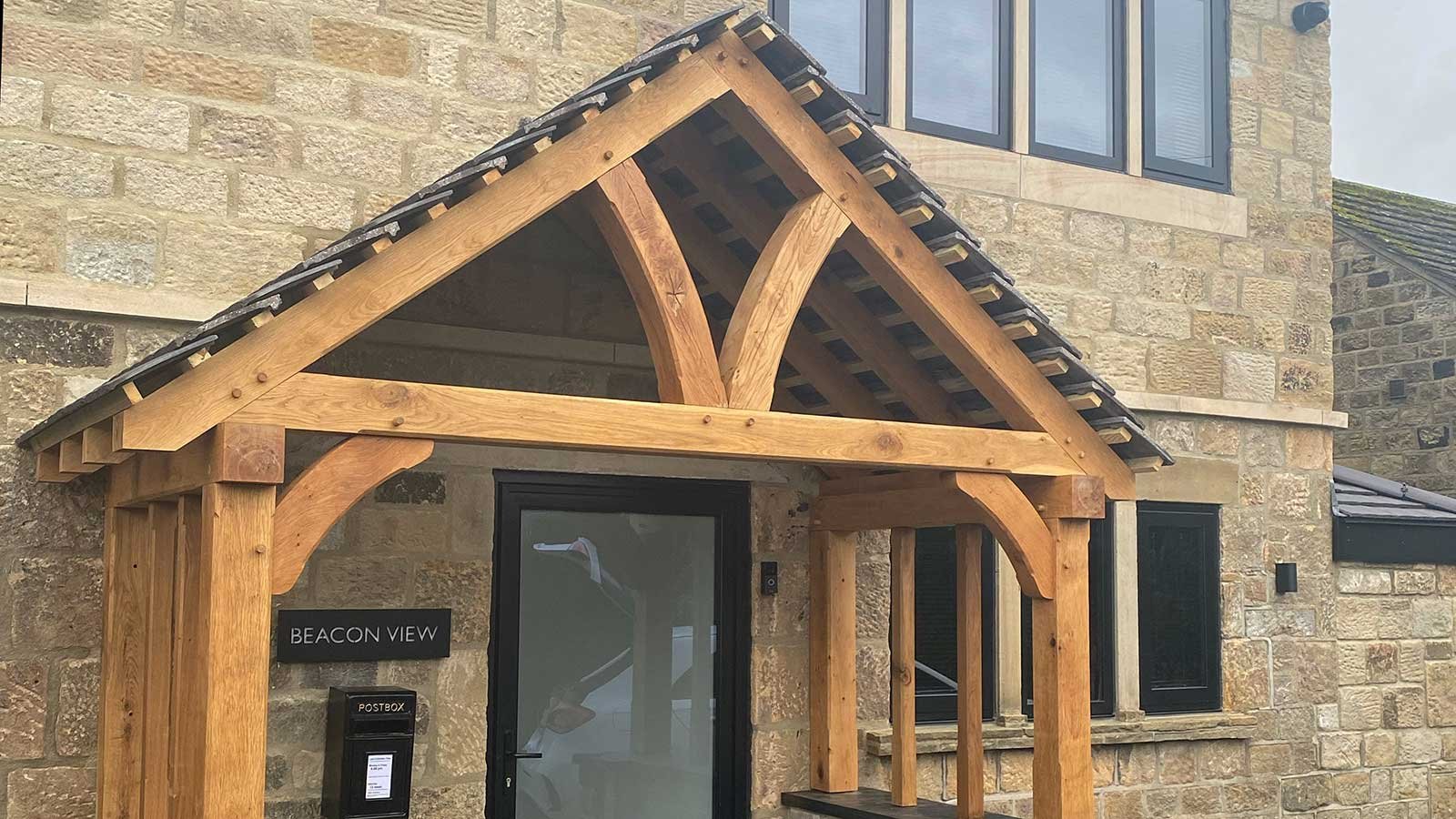
oakbydesign
01423 593 794


A number of years ago, Skipton based builder, Andrew Green, ordered an oak porch for his own house in the Yorkshire Dales.
He made such a lovely job of it, consequently, friends and passers-by saw it and asked him to build them one!
Living on a prominent corner in the village where he lived, Andrew's porch got seen by many people passing by. He even had people stopping their car to ask for details of where he'd bought it!
In July, good friend, Peter Firth, was having a house built and Andrew was working on it when he asked him to build an oak porch like his, on the new house.
The size required was very similar to Andrews:-
2840mm wide by 1500mm deep.
The pitch needed to be 37°.
The length of the posts to the underside of the Oak truss tie beam to be 1200mm.
A quotation was sent, and the oak porch was ordered in August.
Joanne arranged for a drawing of the proposed porch to be sent out for Peter and Andrew to check over. They needed a couple of small alterations making to the overall width and then they approved the drawing.
Prior to the oak porch being delivered Andrew prepared the base and built the walls for the porch. More often than not, a pitched porch will sit centrally with the door, and therefore symmetrically. This porch was to sit asymmetrically, so that a seating area and storage area would sit to the left hand side of the porch.
Once Andrew had built the walls, he took templates for black granite copings, and checked that the porch measurements were still correct – they were!
The design of Andrew’s porch is unusual in that it has intermediary posts between the front and back posts, and Peter chose the same.
He also chose to have the edges of the timbers finished with a stop chamfer. This detail is shown on the photo below.
Peter chose Johnstone’s Satin Woodstain for the finish in Clear. This has a slight sheen to the finish but provides good protection.
Towards the end of November, Joanne arranged delivery of the porch. Andrew took no time at all installing it, and getting the roof on. Peter chose not to have any boards on the underside of the roof, above the oak rafters. Like Andrew, he too prefers to see the back of the roof tiles.
As the house is a new build, the porch needed more of a contemporary look. The porch required rendering and tiling and Andrew finished this during the better weather in the following Spring.
The tiles chosen for the porch floor are a traditional tile but with a contemporary twist – similar to these.
An oak seat fits into the side of the porch, providing a great place to sit and put shoes on, or to take them off!
The tiles lead into the beautifully finished property with a fabulous personalised doormat inside. Between the porch, the tiles and the doormat, a perfect welcome has been created at this Yorkshire home.
Speaking to Peter’s partner, Carrie recently about the porch she said:
“We love it – we’ve had so many compliments on it.”
We can see why, the porch has finished off this lovely home beautifully.
If you are contemplating having an oak porch, and wondering how to finish off the tops of the dwarf walls, read the Blog from our website HERE
Building an oak porch is a significant investment that requires careful consideration and planning. This article will discuss three key factors to consider when embarking on such a project: architectural compatibility, planning permission requirements, and maintenance considerations.
One crucial factor to consider when building an oak porch is its architectural compatibility with your existing home. It is essential to ensure that the design of the porch harmonizes with the overall style and aesthetics of your property. This can be achieved by selecting materials, finishes, and detailing that complement the existing architecture. By doing so, you create a cohesive and visually appealing structure that adds value to your home.
Before commencing any construction work on your oak porch, it is vital to research and understand the planning permission requirements in your area. Different regions have varying regulations regarding the size, height, and location of porches. Familiarize yourself with these guidelines to avoid potential legal issues or delays in your project. Engaging with local authorities or seeking professional advice can help you navigate through this process efficiently.
Lastly, it is crucial to consider the maintenance requirements associated with an oak porch. While oak is a durable material known for its longevity, regular maintenance is necessary to preserve its beauty and structural integrity. This may involve periodic cleaning, treatments such as oiling or staining, and occasional repairs if needed. Being aware of these maintenance tasks beforehand allows you to plan accordingly and ensure that your oak porch remains in optimal condition for years to come.
The utilisation of timber in construction is a time-honoured tradition, with oak being a popular choice due to its durability and aesthetic appeal. However, there are distinct differences between green oak and air-dried oak that warrant careful consideration when selecting the appropriate material for building projects.
Green oak is derived from recently felled trees, retaining a substantial moisture content ranging from 60-80%. As this timber undergoes seasoning, which refers to the gradual drying out process, its moisture content diminishes. The visual imagery of water gradually evaporating from the wood aptly depicts this transformation.
In contrast to green oak, air-dried oak is cut into desired sizes and exposed to natural elements for an extended period. This exposure allows for air circulation between the timbers, facilitating the reduction in moisture content over time. The pace at which air-dried oak dries out is captured by the evocative phrase "25mm per year," highlighting the slow but steady progress of drying.
Air-dried oak possesses lower moisture content compared to green oak due to its lengthy seasoning period, typically ranging from three to ten years depending on thickness. This reduced moisture content enhances stability and minimises movements or shrinkage associated with timber use in construction projects.
Understanding the distinctions between green oak and air-dried oak grants building experts invaluable knowledge when making material selections. By considering factors such as moisture content and stability, professionals can ensure optimal outcomes in their construction endeavours without compromising quality or longevity.
Telephone: 01423 593 794
Locksley Park
Blind Lane
Tockwith
YORK YO26 7QJ
Opening Times:
Mon to Fri - 9.00am to 5.00pm
Bank Holidays - Closed
Christmas 2025- TBC
Oak By Design is the trading name of:
Oak By Design Ltd.
Reg Number: 04384416
VAT Number: 664 8012 33